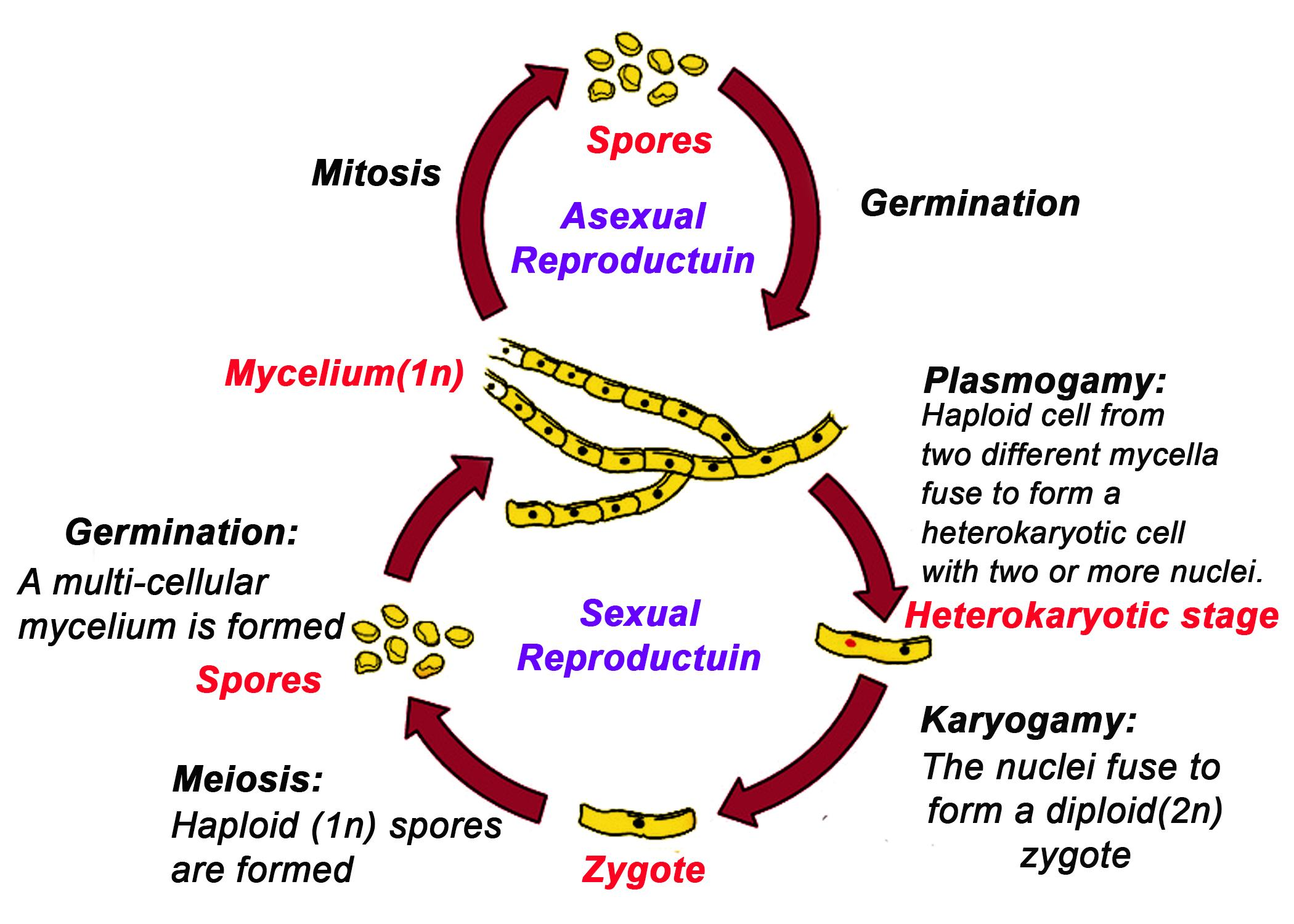
Answer
445.2k+ views
Hint The reproduction in fungi is caused by the asexual means of the reproduction. These asexual means include fragmentation, budding, or production of spores. The hyphae can form fragments that have the ability to give rise to the new colonies of fungi.
Complete answer: In the sexual reproduction of the fungi there is the presence of two-parent cells or the mycelia. In this, the fusion of their cytoplasm occurs but the nuclei do not fuse with each other. This leads to the presence of two nuclei in a single cell. This leads to the nuclei staying close to each other. Then the nuclei fuse together to form the diploid cell and then divide to form the spores. The spores are formed from the meiosis. There is a stage in the fungi which is called plasmogamy which is when the fungi undergo sexual reproduction and the fusion of cytoplasm takes place but the nuclei are unable to divide. In some plants, plasmogamy takes place followed by the karyogamy and in some fungi after plasmogamy, they stay arrested in that phase only, and then karyogamy occurs.

So, the answer is ‘plasmogamy’.
Note: In the sexual reproduction of the fungi there occurs three stages which include plasmogamy, karyogamy, and meiosis. In fungi, the sexual reproduction occurs when the environmental conditions get worse for the fungi. The reproduction occurs through the mycelium. In karyogamy, the nuclei fuse to form a diploid zygote nucleus. And when meiosis takes place then spores formed are released into the air.
Complete answer: In the sexual reproduction of the fungi there is the presence of two-parent cells or the mycelia. In this, the fusion of their cytoplasm occurs but the nuclei do not fuse with each other. This leads to the presence of two nuclei in a single cell. This leads to the nuclei staying close to each other. Then the nuclei fuse together to form the diploid cell and then divide to form the spores. The spores are formed from the meiosis. There is a stage in the fungi which is called plasmogamy which is when the fungi undergo sexual reproduction and the fusion of cytoplasm takes place but the nuclei are unable to divide. In some plants, plasmogamy takes place followed by the karyogamy and in some fungi after plasmogamy, they stay arrested in that phase only, and then karyogamy occurs.

So, the answer is ‘plasmogamy’.
Note: In the sexual reproduction of the fungi there occurs three stages which include plasmogamy, karyogamy, and meiosis. In fungi, the sexual reproduction occurs when the environmental conditions get worse for the fungi. The reproduction occurs through the mycelium. In karyogamy, the nuclei fuse to form a diploid zygote nucleus. And when meiosis takes place then spores formed are released into the air.
Recently Updated Pages
Fill in the blanks with suitable prepositions Break class 10 english CBSE

Fill in the blanks with suitable articles Tribune is class 10 english CBSE

Rearrange the following words and phrases to form a class 10 english CBSE

Select the opposite of the given word Permit aGive class 10 english CBSE

Fill in the blank with the most appropriate option class 10 english CBSE

Some places have oneline notices Which option is a class 10 english CBSE

Trending doubts
Fill the blanks with the suitable prepositions 1 The class 9 english CBSE

How do you graph the function fx 4x class 9 maths CBSE

Which are the Top 10 Largest Countries of the World?

What is the definite integral of zero a constant b class 12 maths CBSE

The Equation xxx + 2 is Satisfied when x is Equal to Class 10 Maths

Differentiate between homogeneous and heterogeneous class 12 chemistry CBSE

Define the term system surroundings open system closed class 11 chemistry CBSE

Full Form of IASDMIPSIFSIRSPOLICE class 7 social science CBSE

Change the following sentences into negative and interrogative class 10 english CBSE




